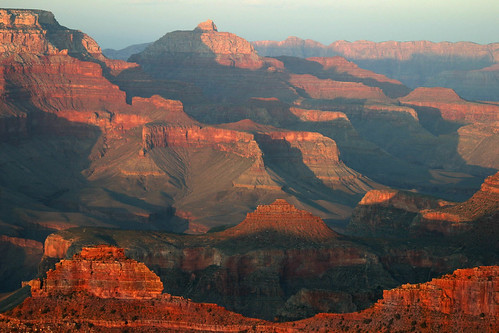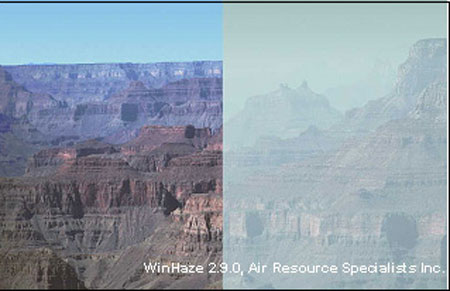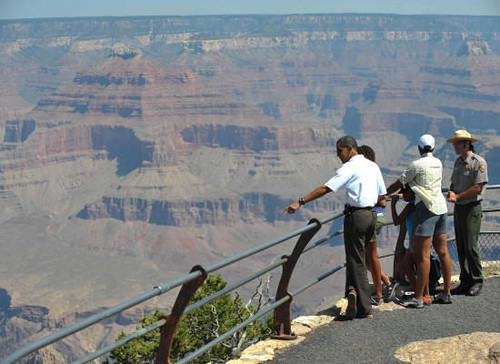 The great national parks of the Southwest overwhelm visitors with a sense of space. The air is limitless, dazzling, so crystalline clear it pierces the lungs and the soul. On the rim of the Grand Canyon, you imagine you can see forever -- an average of 106 miles, and up to 160 miles on clearest days. Bryce Canyon, with its aptly named Farview Point, offers panoramic views of three states, visibility up to 200 miles, and "dark skies" night astronomy programs in which visitors can see up to 7500 stars. Red sandstone of Delicate Arch, in Arches National Park, frames a perfect blue sky.
The great national parks of the Southwest overwhelm visitors with a sense of space. The air is limitless, dazzling, so crystalline clear it pierces the lungs and the soul. On the rim of the Grand Canyon, you imagine you can see forever -- an average of 106 miles, and up to 160 miles on clearest days. Bryce Canyon, with its aptly named Farview Point, offers panoramic views of three states, visibility up to 200 miles, and "dark skies" night astronomy programs in which visitors can see up to 7500 stars. Red sandstone of Delicate Arch, in Arches National Park, frames a perfect blue sky. Unless the haze obstructs the view.
One purpose of the Clean Air Act is "to preserve, protect, and enhance the air quality in national parks." Most national parks, wilderness areas, and certain national forests and national wildlife refuges are labeled Class I, giving the involved federal agency some obligation to prevent significant deterioration of air quality caused by outside sources within 300 kilometers.
 An entire federal program, Interagency Monitoring of Protected Visual Environments, or IMPROVE, is dedicated to monitoring and protecting air quality in the national parks and wilderness areas. Many parks have webcams, showing not only a view of the park but also air quality, such as the informative Grand Canyon webcam. (True confession -- I use the Yosemite webcam page as a mental health break.)
An entire federal program, Interagency Monitoring of Protected Visual Environments, or IMPROVE, is dedicated to monitoring and protecting air quality in the national parks and wilderness areas. Many parks have webcams, showing not only a view of the park but also air quality, such as the informative Grand Canyon webcam. (True confession -- I use the Yosemite webcam page as a mental health break.)The NPS' most recent 2008 report on air quality in parks shows that ozone levels at Great Basin (NV) and Mesa Verde (CO), both remote parks far from any large population center, are surprisingly high and are of particular concern.
The Bush administration proposed weakening the Class I rules by permitting coal plants and other haze-creators to be placed closer to national parks. The National Parks Conservation Association identified ten parks most threatened by coal plants in Dark Horizons (33 pg pdf), including Capitol Reef (UT), Great Basin, Mesa Verde, and Zion (UT) National Parks. Ultimately the Bush administration backed down.
 Two notorious sources of haze in the Southwest are the Four Corners and Black Mesa coal plants.
Two notorious sources of haze in the Southwest are the Four Corners and Black Mesa coal plants. The Four Corners plant, located west of Farmington, NM burns 10 million tons of coal every year. It's the largest single source of air pollution in the state of New Mexico, according to the Arizona Public Service's monitoring reports. And the NPS has found that Four Corners has the greatest visibility impact on Class I national parks of any coal plant in the country. The coal plant particularly threatens clean, clear air at Arches, Canyonlands, and Mesa Verde national parks. Last month, a coalition of environmental groups petitioned the DOI and USDA to declare that the Four Corners plant is violating the Clean Air Act by polluting the air at sixteen Class I national parks.
The Black Mesa power plant complex, no stranger to controversy, was set up with apparent sweetheart deals on Hopi and Navajo land in the 1960s. The complex consists of two separate strip mining operations: Black Mesa and Kayenta. Black Mesa was shut down in 2005 rather than comply with environmental regulations, while Kayenta kept going. As part of the Bush administration midnight anti-environmental regulations in December 2008, a permit to combine the two (effectively reopening Black Mesa) for the life of the mine was approved. However, in January 2010, an administrative law judge rescinded the permit, sending the reopening of Black Mesa back to the drawing board for a new environmental impact statement. Chalk this victory up for the good guys. (Note: the Black Mesa story has layers of tragedy, exploitation, and environmental injustice going far beyond haze over the Grand Canyon. Black Mesa Indigenous Support and similar websites have more information than can be covered in this diary.)
The casual national park visitor's view over the Grand Canyon is certainly not the only reason to shut down places like Four Corners and Black Mesa. However, it's another harm instigated by the burning of fossil fuels, another reason to convince your nonpolitical friends that we need to move to clean energy, and another reason why carbon pollution should not continue unchecked.
No comments:
Post a Comment